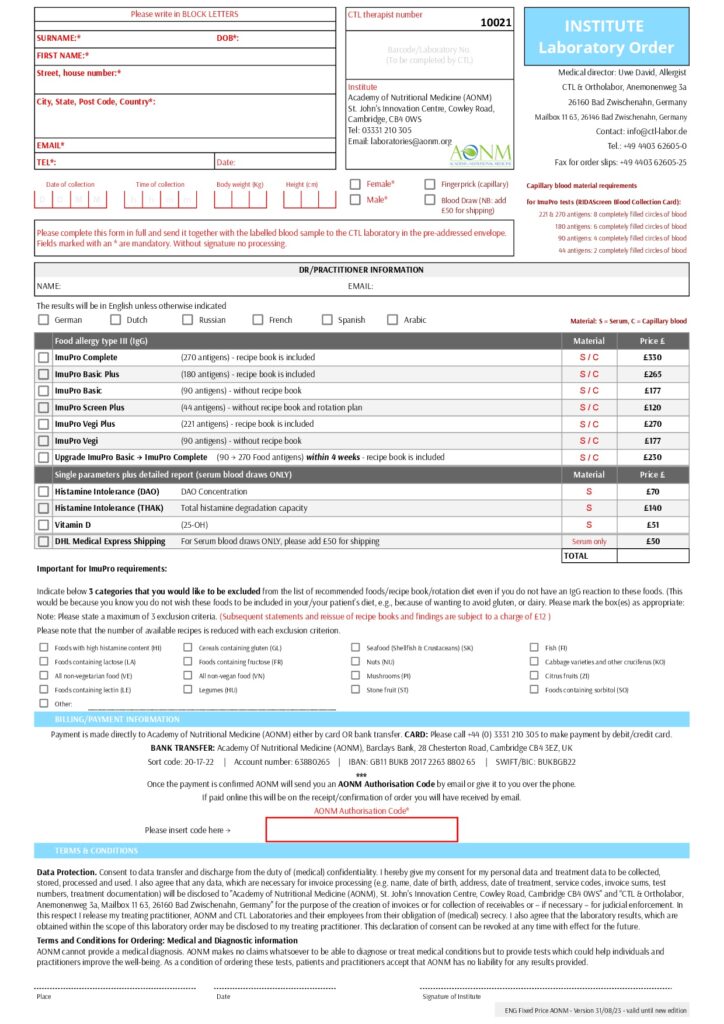Procedure for testing
Learn More About Food Intolerance Testing
A few general points on the ImuPro test
The ImuPro blood sample may be obtained by either:
Venous blood draw
– blood sample (serum) is drawn by a qualified phlebotomist, centrifuged, and sent to the lab via courier.
Capillary blood (fingerprick)
– practitioner or patient collects the sample themselves, and blood spots are sent by normal post.
- The tests cost the same to analyse
- In the blood draw test, food reactions are grouped from 1 (mildest reaction) to 4 (strongest reaction) based on the strength of reaction, so you will get 4 levels of sensitivity
- The capillary test combines groups 1 and 2 but shows groups 3 and 4 separately, so you will get 3 levels of sensitivity
- The capillary test avoids additional expenses for the blood draw and courier.
- Centrifuge the sample (10 minutes at 3000 RPM) OR let it stand upright for a minimum of 30 minutes to separate blood cells from serum.
- If centrifuged – pipette off the serum and transfer it to the Transfer Tube.
- If not centrifuged – ensure the serum vacutainer is shipped to the Laboratory on the same day.
We recommend prioritising centrifugation, which eliminates the need for same-day posting.
The test kit contains 1x RIDASCREEN® Foodscreen Blood CollectionCard, sterile alcohol swabs & sterile lancets.
- Swipe finger with the alcohol swab, let it dry, then insert a lancet to a depth of 2 mm.
- Apply blood drop onto the first circle without touching the card. It may require multiple drops to fill each circle. Repeat until 2-9 circles are filled (9 for ProImmun M Plus [270 antigens]). Avoid touching the card with your finger.
- Air-dry the card overnight, then fold and place it in the provided plastic bag with the desiccant.
- Place the bag, along with the laboratory request form, in an envelope and mail it to the address provided.
You or your patient should not conduct the ImuPro test if:
- They have a temperature; please wait until it has gone down.
- They are on cortisone therapy/steroids: If the therapy is short term, i.e., less than eight weeks, please wait until the patient has been off the therapy for four weeks and then conduct the test. If the patient is on long-term cortisone therapy, please do the test regardless (as the patient would never otherwise do the IgG food intolerance test), but be aware that the markers will be weaker than normal (as the therapy suppresses IgG reactions). You will need to see a strength 1 or 2 reaction as likely to represent a strength 4 reaction (i.e., the patient would have had a stronger reaction if not on cortisone therapy), and your advice (re. how long to stay off the food, etc.) should be based on that assumption.
- They are on chemotherapy. If the chemotherapy is short term (up to eight weeks), please wait until the patient has been off the therapy for four weeks and then conduct the test. If the therapy is longer term, please conduct the test anyway (because the benefits outweigh the disadvantages), but the constraints are the same as mentioned above re. the strength of reaction.

